LOOG5026 Logistics and Operations: Royal Dutch Shell Supply Chain
VerifiedAdded on 2023/06/13
|11
|2923
|50
Report
AI Summary
This report delves into the intricacies of supply chain management within the oil and gas industry, using Royal Dutch Shell as a case study. It explores the benefits and challenges of expanding into gas refinery, the design of an effective supply chain for the Kenyan market, and the similarities and differences between service and product supply chains. Furthermore, the report examines the interaction of staff members with technology and suggests ways to smoothen this interaction through ERP systems and the Internet of Things, ultimately aiming to optimize efficiency and reduce errors in the supply chain process. This student contributed assignment is available on Desklib, a platform providing a wealth of study resources for students.
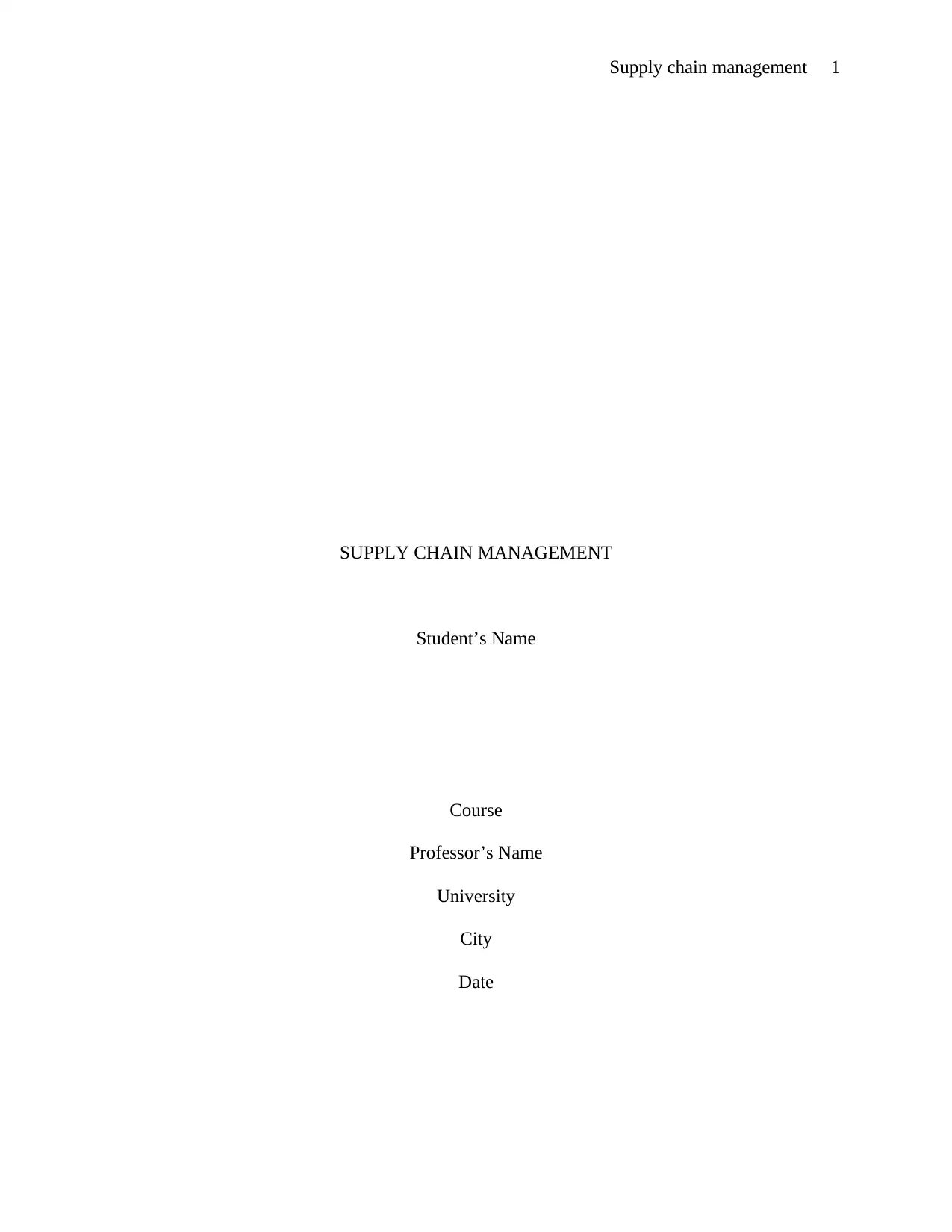
Supply chain management 1
SUPPLY CHAIN MANAGEMENT
Student’s Name
Course
Professor’s Name
University
City
Date
SUPPLY CHAIN MANAGEMENT
Student’s Name
Course
Professor’s Name
University
City
Date
Paraphrase This Document
Need a fresh take? Get an instant paraphrase of this document with our AI Paraphraser
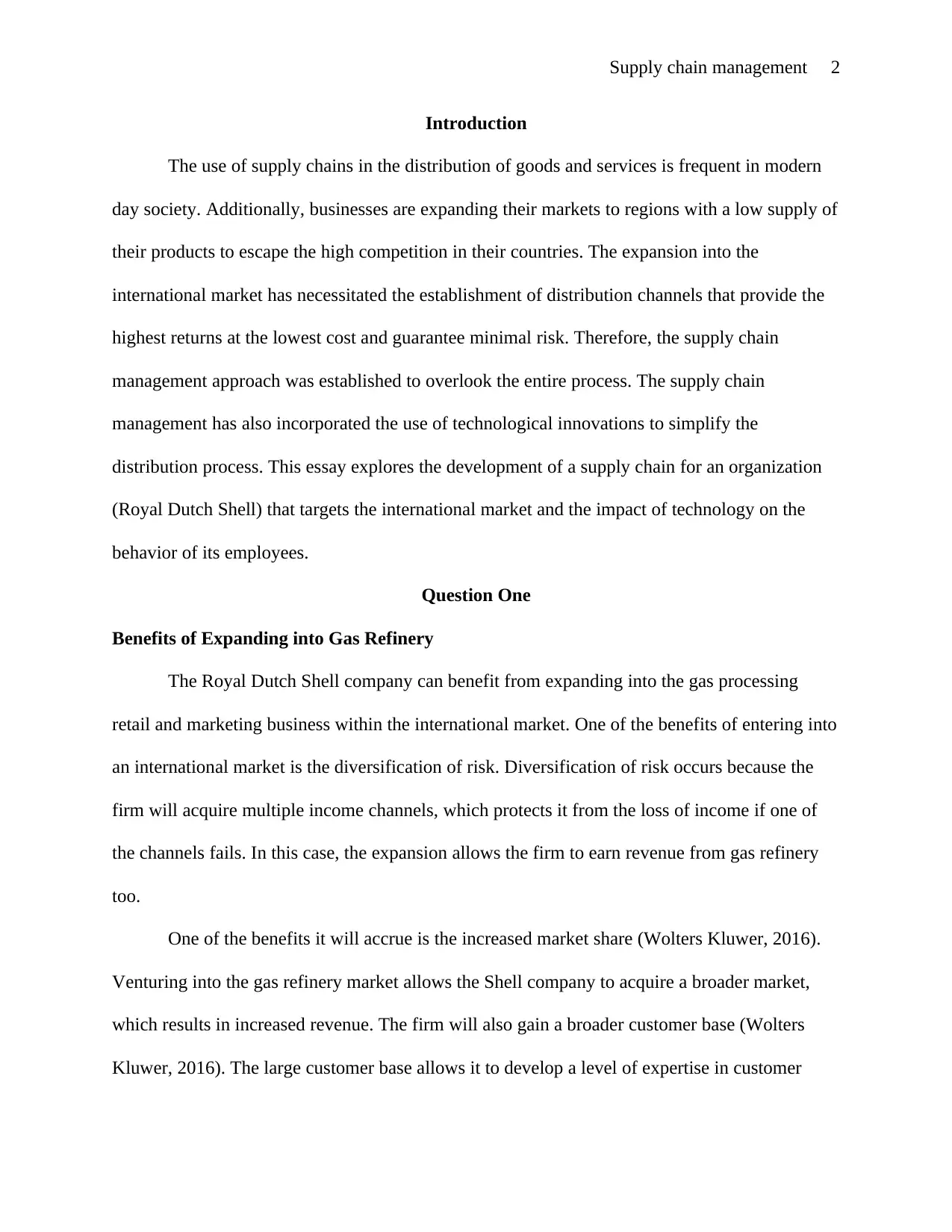
Supply chain management 2
Introduction
The use of supply chains in the distribution of goods and services is frequent in modern
day society. Additionally, businesses are expanding their markets to regions with a low supply of
their products to escape the high competition in their countries. The expansion into the
international market has necessitated the establishment of distribution channels that provide the
highest returns at the lowest cost and guarantee minimal risk. Therefore, the supply chain
management approach was established to overlook the entire process. The supply chain
management has also incorporated the use of technological innovations to simplify the
distribution process. This essay explores the development of a supply chain for an organization
(Royal Dutch Shell) that targets the international market and the impact of technology on the
behavior of its employees.
Question One
Benefits of Expanding into Gas Refinery
The Royal Dutch Shell company can benefit from expanding into the gas processing
retail and marketing business within the international market. One of the benefits of entering into
an international market is the diversification of risk. Diversification of risk occurs because the
firm will acquire multiple income channels, which protects it from the loss of income if one of
the channels fails. In this case, the expansion allows the firm to earn revenue from gas refinery
too.
One of the benefits it will accrue is the increased market share (Wolters Kluwer, 2016).
Venturing into the gas refinery market allows the Shell company to acquire a broader market,
which results in increased revenue. The firm will also gain a broader customer base (Wolters
Kluwer, 2016). The large customer base allows it to develop a level of expertise in customer
Introduction
The use of supply chains in the distribution of goods and services is frequent in modern
day society. Additionally, businesses are expanding their markets to regions with a low supply of
their products to escape the high competition in their countries. The expansion into the
international market has necessitated the establishment of distribution channels that provide the
highest returns at the lowest cost and guarantee minimal risk. Therefore, the supply chain
management approach was established to overlook the entire process. The supply chain
management has also incorporated the use of technological innovations to simplify the
distribution process. This essay explores the development of a supply chain for an organization
(Royal Dutch Shell) that targets the international market and the impact of technology on the
behavior of its employees.
Question One
Benefits of Expanding into Gas Refinery
The Royal Dutch Shell company can benefit from expanding into the gas processing
retail and marketing business within the international market. One of the benefits of entering into
an international market is the diversification of risk. Diversification of risk occurs because the
firm will acquire multiple income channels, which protects it from the loss of income if one of
the channels fails. In this case, the expansion allows the firm to earn revenue from gas refinery
too.
One of the benefits it will accrue is the increased market share (Wolters Kluwer, 2016).
Venturing into the gas refinery market allows the Shell company to acquire a broader market,
which results in increased revenue. The firm will also gain a broader customer base (Wolters
Kluwer, 2016). The large customer base allows it to develop a level of expertise in customer
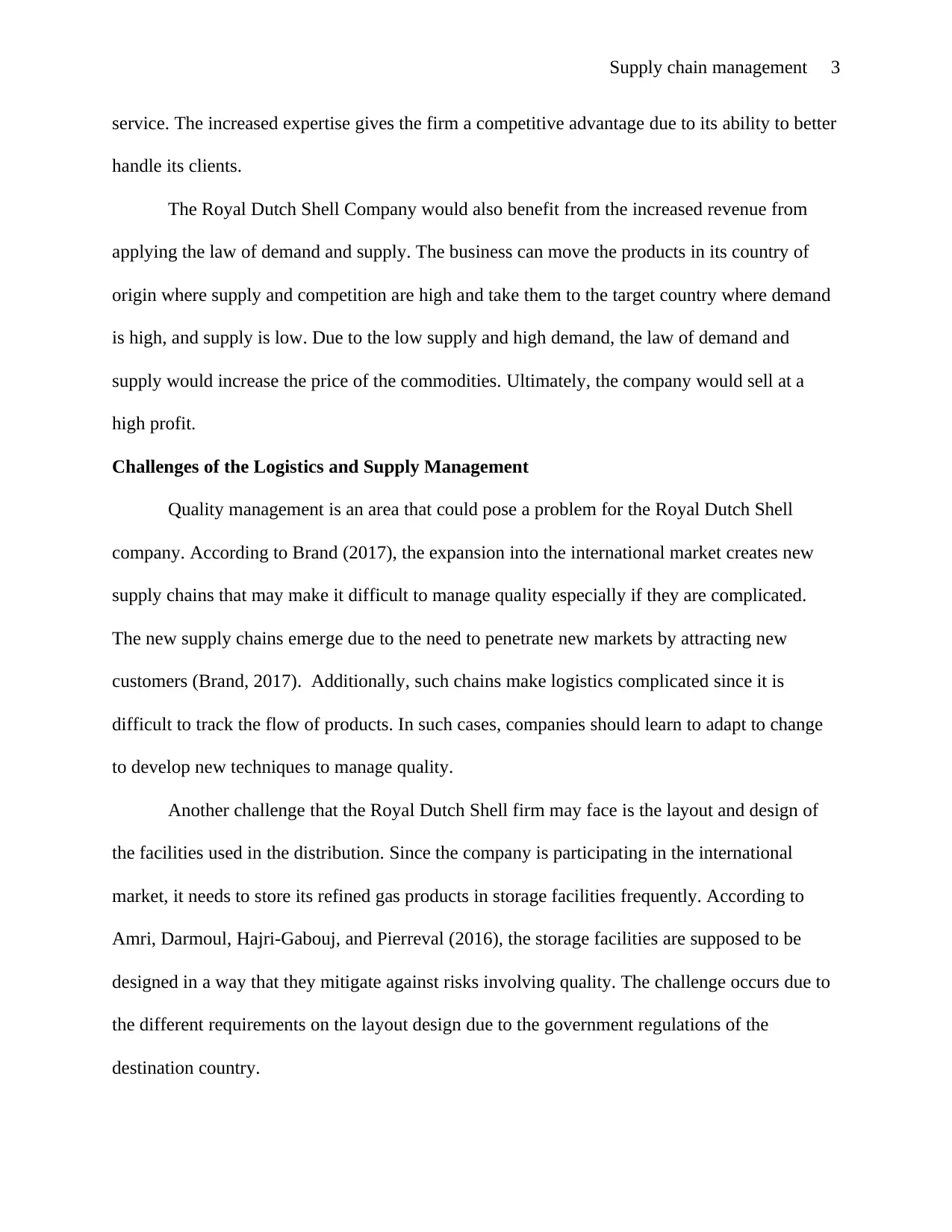
Supply chain management 3
service. The increased expertise gives the firm a competitive advantage due to its ability to better
handle its clients.
The Royal Dutch Shell Company would also benefit from the increased revenue from
applying the law of demand and supply. The business can move the products in its country of
origin where supply and competition are high and take them to the target country where demand
is high, and supply is low. Due to the low supply and high demand, the law of demand and
supply would increase the price of the commodities. Ultimately, the company would sell at a
high profit.
Challenges of the Logistics and Supply Management
Quality management is an area that could pose a problem for the Royal Dutch Shell
company. According to Brand (2017), the expansion into the international market creates new
supply chains that may make it difficult to manage quality especially if they are complicated.
The new supply chains emerge due to the need to penetrate new markets by attracting new
customers (Brand, 2017). Additionally, such chains make logistics complicated since it is
difficult to track the flow of products. In such cases, companies should learn to adapt to change
to develop new techniques to manage quality.
Another challenge that the Royal Dutch Shell firm may face is the layout and design of
the facilities used in the distribution. Since the company is participating in the international
market, it needs to store its refined gas products in storage facilities frequently. According to
Amri, Darmoul, Hajri-Gabouj, and Pierreval (2016), the storage facilities are supposed to be
designed in a way that they mitigate against risks involving quality. The challenge occurs due to
the different requirements on the layout design due to the government regulations of the
destination country.
service. The increased expertise gives the firm a competitive advantage due to its ability to better
handle its clients.
The Royal Dutch Shell Company would also benefit from the increased revenue from
applying the law of demand and supply. The business can move the products in its country of
origin where supply and competition are high and take them to the target country where demand
is high, and supply is low. Due to the low supply and high demand, the law of demand and
supply would increase the price of the commodities. Ultimately, the company would sell at a
high profit.
Challenges of the Logistics and Supply Management
Quality management is an area that could pose a problem for the Royal Dutch Shell
company. According to Brand (2017), the expansion into the international market creates new
supply chains that may make it difficult to manage quality especially if they are complicated.
The new supply chains emerge due to the need to penetrate new markets by attracting new
customers (Brand, 2017). Additionally, such chains make logistics complicated since it is
difficult to track the flow of products. In such cases, companies should learn to adapt to change
to develop new techniques to manage quality.
Another challenge that the Royal Dutch Shell firm may face is the layout and design of
the facilities used in the distribution. Since the company is participating in the international
market, it needs to store its refined gas products in storage facilities frequently. According to
Amri, Darmoul, Hajri-Gabouj, and Pierreval (2016), the storage facilities are supposed to be
designed in a way that they mitigate against risks involving quality. The challenge occurs due to
the different requirements on the layout design due to the government regulations of the
destination country.
⊘ This is a preview!⊘
Do you want full access?
Subscribe today to unlock all pages.

Trusted by 1+ million students worldwide
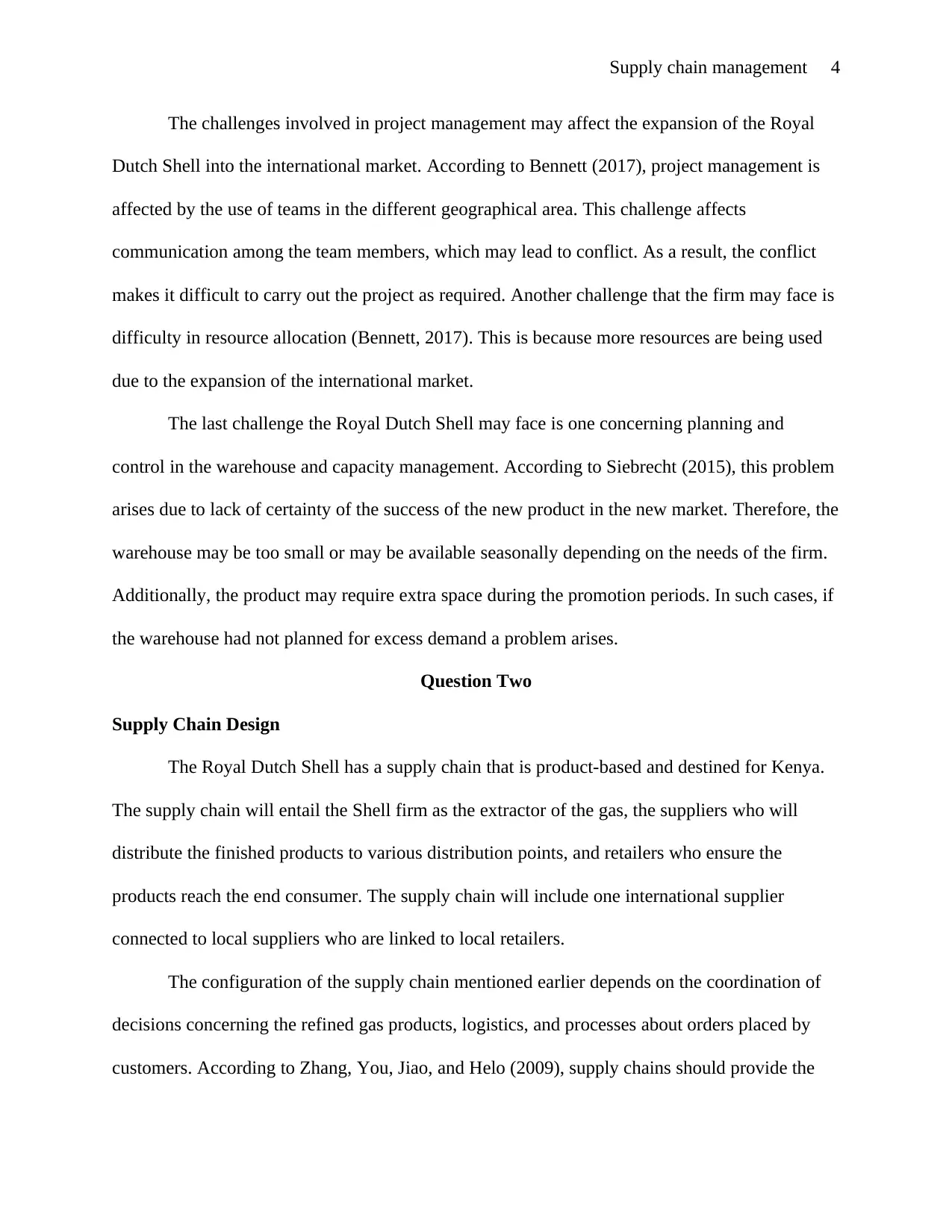
Supply chain management 4
The challenges involved in project management may affect the expansion of the Royal
Dutch Shell into the international market. According to Bennett (2017), project management is
affected by the use of teams in the different geographical area. This challenge affects
communication among the team members, which may lead to conflict. As a result, the conflict
makes it difficult to carry out the project as required. Another challenge that the firm may face is
difficulty in resource allocation (Bennett, 2017). This is because more resources are being used
due to the expansion of the international market.
The last challenge the Royal Dutch Shell may face is one concerning planning and
control in the warehouse and capacity management. According to Siebrecht (2015), this problem
arises due to lack of certainty of the success of the new product in the new market. Therefore, the
warehouse may be too small or may be available seasonally depending on the needs of the firm.
Additionally, the product may require extra space during the promotion periods. In such cases, if
the warehouse had not planned for excess demand a problem arises.
Question Two
Supply Chain Design
The Royal Dutch Shell has a supply chain that is product-based and destined for Kenya.
The supply chain will entail the Shell firm as the extractor of the gas, the suppliers who will
distribute the finished products to various distribution points, and retailers who ensure the
products reach the end consumer. The supply chain will include one international supplier
connected to local suppliers who are linked to local retailers.
The configuration of the supply chain mentioned earlier depends on the coordination of
decisions concerning the refined gas products, logistics, and processes about orders placed by
customers. According to Zhang, You, Jiao, and Helo (2009), supply chains should provide the
The challenges involved in project management may affect the expansion of the Royal
Dutch Shell into the international market. According to Bennett (2017), project management is
affected by the use of teams in the different geographical area. This challenge affects
communication among the team members, which may lead to conflict. As a result, the conflict
makes it difficult to carry out the project as required. Another challenge that the firm may face is
difficulty in resource allocation (Bennett, 2017). This is because more resources are being used
due to the expansion of the international market.
The last challenge the Royal Dutch Shell may face is one concerning planning and
control in the warehouse and capacity management. According to Siebrecht (2015), this problem
arises due to lack of certainty of the success of the new product in the new market. Therefore, the
warehouse may be too small or may be available seasonally depending on the needs of the firm.
Additionally, the product may require extra space during the promotion periods. In such cases, if
the warehouse had not planned for excess demand a problem arises.
Question Two
Supply Chain Design
The Royal Dutch Shell has a supply chain that is product-based and destined for Kenya.
The supply chain will entail the Shell firm as the extractor of the gas, the suppliers who will
distribute the finished products to various distribution points, and retailers who ensure the
products reach the end consumer. The supply chain will include one international supplier
connected to local suppliers who are linked to local retailers.
The configuration of the supply chain mentioned earlier depends on the coordination of
decisions concerning the refined gas products, logistics, and processes about orders placed by
customers. According to Zhang, You, Jiao, and Helo (2009), supply chains should provide the
Paraphrase This Document
Need a fresh take? Get an instant paraphrase of this document with our AI Paraphraser
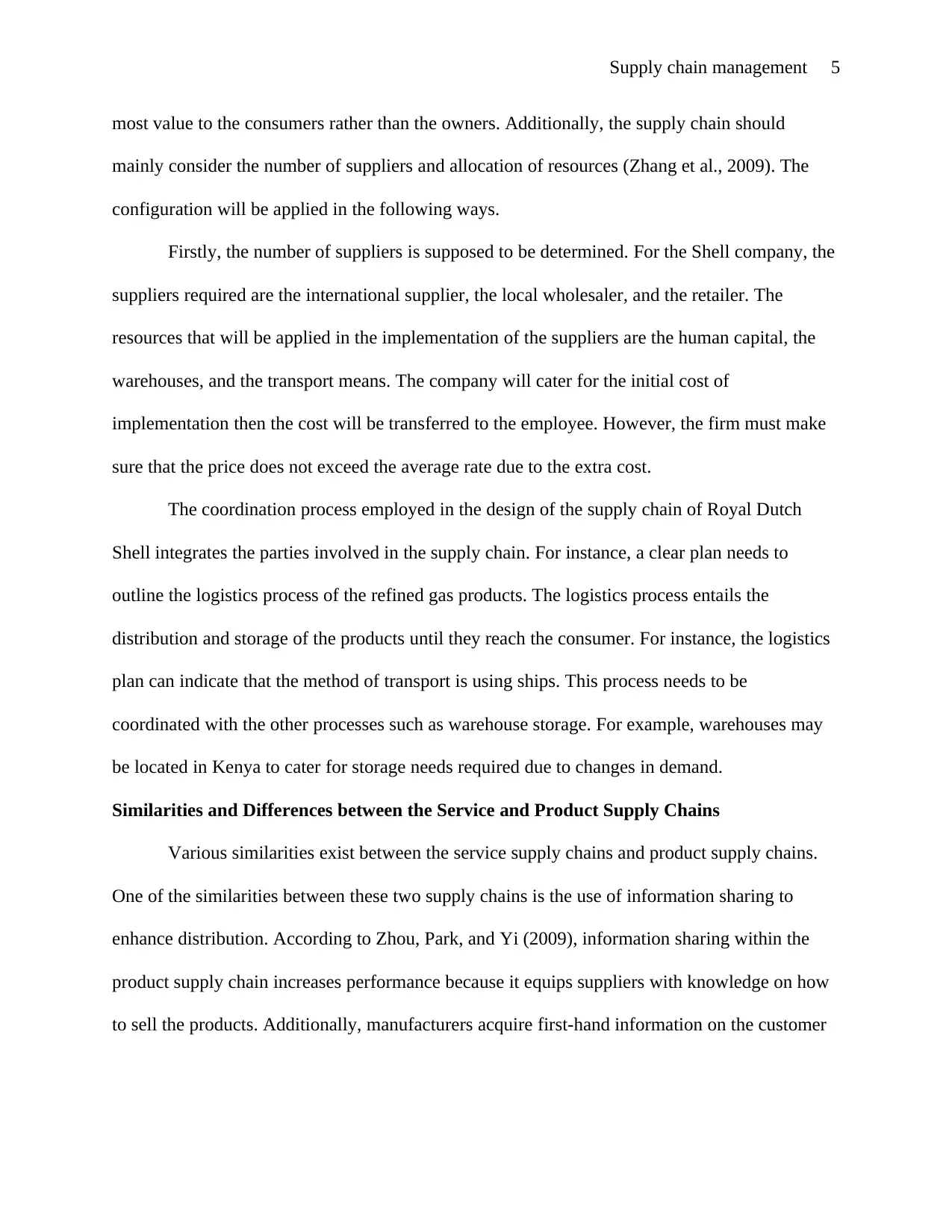
Supply chain management 5
most value to the consumers rather than the owners. Additionally, the supply chain should
mainly consider the number of suppliers and allocation of resources (Zhang et al., 2009). The
configuration will be applied in the following ways.
Firstly, the number of suppliers is supposed to be determined. For the Shell company, the
suppliers required are the international supplier, the local wholesaler, and the retailer. The
resources that will be applied in the implementation of the suppliers are the human capital, the
warehouses, and the transport means. The company will cater for the initial cost of
implementation then the cost will be transferred to the employee. However, the firm must make
sure that the price does not exceed the average rate due to the extra cost.
The coordination process employed in the design of the supply chain of Royal Dutch
Shell integrates the parties involved in the supply chain. For instance, a clear plan needs to
outline the logistics process of the refined gas products. The logistics process entails the
distribution and storage of the products until they reach the consumer. For instance, the logistics
plan can indicate that the method of transport is using ships. This process needs to be
coordinated with the other processes such as warehouse storage. For example, warehouses may
be located in Kenya to cater for storage needs required due to changes in demand.
Similarities and Differences between the Service and Product Supply Chains
Various similarities exist between the service supply chains and product supply chains.
One of the similarities between these two supply chains is the use of information sharing to
enhance distribution. According to Zhou, Park, and Yi (2009), information sharing within the
product supply chain increases performance because it equips suppliers with knowledge on how
to sell the products. Additionally, manufacturers acquire first-hand information on the customer
most value to the consumers rather than the owners. Additionally, the supply chain should
mainly consider the number of suppliers and allocation of resources (Zhang et al., 2009). The
configuration will be applied in the following ways.
Firstly, the number of suppliers is supposed to be determined. For the Shell company, the
suppliers required are the international supplier, the local wholesaler, and the retailer. The
resources that will be applied in the implementation of the suppliers are the human capital, the
warehouses, and the transport means. The company will cater for the initial cost of
implementation then the cost will be transferred to the employee. However, the firm must make
sure that the price does not exceed the average rate due to the extra cost.
The coordination process employed in the design of the supply chain of Royal Dutch
Shell integrates the parties involved in the supply chain. For instance, a clear plan needs to
outline the logistics process of the refined gas products. The logistics process entails the
distribution and storage of the products until they reach the consumer. For instance, the logistics
plan can indicate that the method of transport is using ships. This process needs to be
coordinated with the other processes such as warehouse storage. For example, warehouses may
be located in Kenya to cater for storage needs required due to changes in demand.
Similarities and Differences between the Service and Product Supply Chains
Various similarities exist between the service supply chains and product supply chains.
One of the similarities between these two supply chains is the use of information sharing to
enhance distribution. According to Zhou, Park, and Yi (2009), information sharing within the
product supply chain increases performance because it equips suppliers with knowledge on how
to sell the products. Additionally, manufacturers acquire first-hand information on the customer
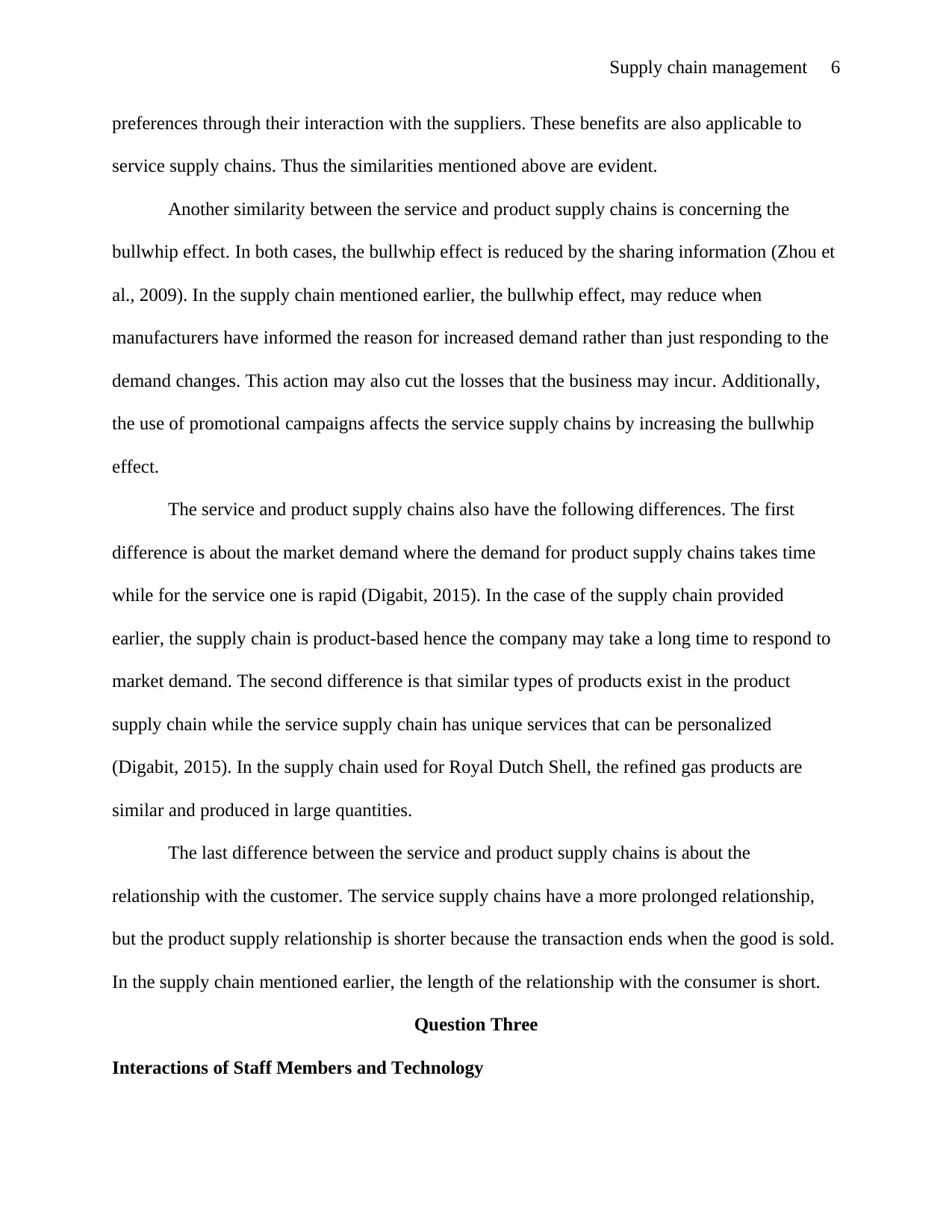
Supply chain management 6
preferences through their interaction with the suppliers. These benefits are also applicable to
service supply chains. Thus the similarities mentioned above are evident.
Another similarity between the service and product supply chains is concerning the
bullwhip effect. In both cases, the bullwhip effect is reduced by the sharing information (Zhou et
al., 2009). In the supply chain mentioned earlier, the bullwhip effect, may reduce when
manufacturers have informed the reason for increased demand rather than just responding to the
demand changes. This action may also cut the losses that the business may incur. Additionally,
the use of promotional campaigns affects the service supply chains by increasing the bullwhip
effect.
The service and product supply chains also have the following differences. The first
difference is about the market demand where the demand for product supply chains takes time
while for the service one is rapid (Digabit, 2015). In the case of the supply chain provided
earlier, the supply chain is product-based hence the company may take a long time to respond to
market demand. The second difference is that similar types of products exist in the product
supply chain while the service supply chain has unique services that can be personalized
(Digabit, 2015). In the supply chain used for Royal Dutch Shell, the refined gas products are
similar and produced in large quantities.
The last difference between the service and product supply chains is about the
relationship with the customer. The service supply chains have a more prolonged relationship,
but the product supply relationship is shorter because the transaction ends when the good is sold.
In the supply chain mentioned earlier, the length of the relationship with the consumer is short.
Question Three
Interactions of Staff Members and Technology
preferences through their interaction with the suppliers. These benefits are also applicable to
service supply chains. Thus the similarities mentioned above are evident.
Another similarity between the service and product supply chains is concerning the
bullwhip effect. In both cases, the bullwhip effect is reduced by the sharing information (Zhou et
al., 2009). In the supply chain mentioned earlier, the bullwhip effect, may reduce when
manufacturers have informed the reason for increased demand rather than just responding to the
demand changes. This action may also cut the losses that the business may incur. Additionally,
the use of promotional campaigns affects the service supply chains by increasing the bullwhip
effect.
The service and product supply chains also have the following differences. The first
difference is about the market demand where the demand for product supply chains takes time
while for the service one is rapid (Digabit, 2015). In the case of the supply chain provided
earlier, the supply chain is product-based hence the company may take a long time to respond to
market demand. The second difference is that similar types of products exist in the product
supply chain while the service supply chain has unique services that can be personalized
(Digabit, 2015). In the supply chain used for Royal Dutch Shell, the refined gas products are
similar and produced in large quantities.
The last difference between the service and product supply chains is about the
relationship with the customer. The service supply chains have a more prolonged relationship,
but the product supply relationship is shorter because the transaction ends when the good is sold.
In the supply chain mentioned earlier, the length of the relationship with the consumer is short.
Question Three
Interactions of Staff Members and Technology
⊘ This is a preview!⊘
Do you want full access?
Subscribe today to unlock all pages.

Trusted by 1+ million students worldwide
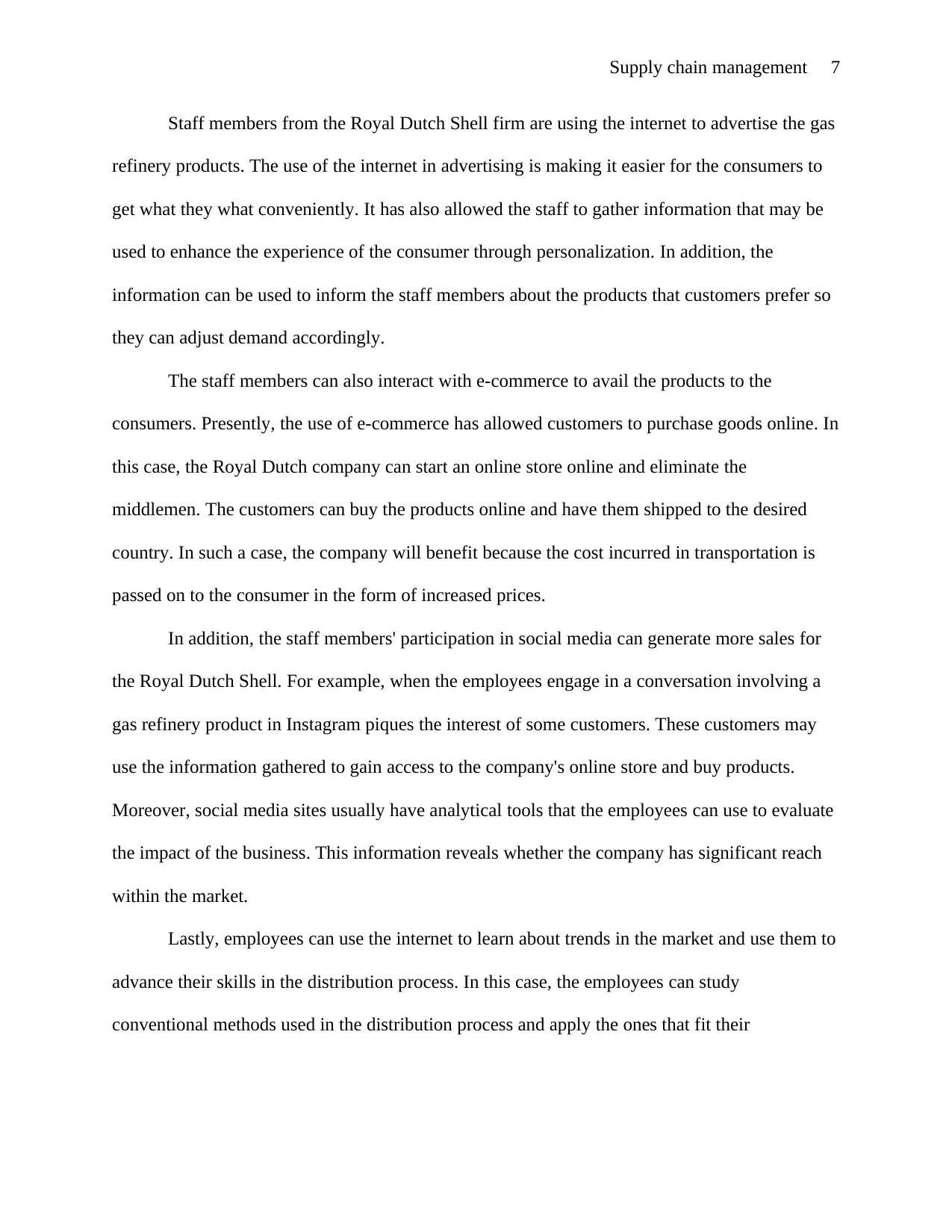
Supply chain management 7
Staff members from the Royal Dutch Shell firm are using the internet to advertise the gas
refinery products. The use of the internet in advertising is making it easier for the consumers to
get what they what conveniently. It has also allowed the staff to gather information that may be
used to enhance the experience of the consumer through personalization. In addition, the
information can be used to inform the staff members about the products that customers prefer so
they can adjust demand accordingly.
The staff members can also interact with e-commerce to avail the products to the
consumers. Presently, the use of e-commerce has allowed customers to purchase goods online. In
this case, the Royal Dutch company can start an online store online and eliminate the
middlemen. The customers can buy the products online and have them shipped to the desired
country. In such a case, the company will benefit because the cost incurred in transportation is
passed on to the consumer in the form of increased prices.
In addition, the staff members' participation in social media can generate more sales for
the Royal Dutch Shell. For example, when the employees engage in a conversation involving a
gas refinery product in Instagram piques the interest of some customers. These customers may
use the information gathered to gain access to the company's online store and buy products.
Moreover, social media sites usually have analytical tools that the employees can use to evaluate
the impact of the business. This information reveals whether the company has significant reach
within the market.
Lastly, employees can use the internet to learn about trends in the market and use them to
advance their skills in the distribution process. In this case, the employees can study
conventional methods used in the distribution process and apply the ones that fit their
Staff members from the Royal Dutch Shell firm are using the internet to advertise the gas
refinery products. The use of the internet in advertising is making it easier for the consumers to
get what they what conveniently. It has also allowed the staff to gather information that may be
used to enhance the experience of the consumer through personalization. In addition, the
information can be used to inform the staff members about the products that customers prefer so
they can adjust demand accordingly.
The staff members can also interact with e-commerce to avail the products to the
consumers. Presently, the use of e-commerce has allowed customers to purchase goods online. In
this case, the Royal Dutch company can start an online store online and eliminate the
middlemen. The customers can buy the products online and have them shipped to the desired
country. In such a case, the company will benefit because the cost incurred in transportation is
passed on to the consumer in the form of increased prices.
In addition, the staff members' participation in social media can generate more sales for
the Royal Dutch Shell. For example, when the employees engage in a conversation involving a
gas refinery product in Instagram piques the interest of some customers. These customers may
use the information gathered to gain access to the company's online store and buy products.
Moreover, social media sites usually have analytical tools that the employees can use to evaluate
the impact of the business. This information reveals whether the company has significant reach
within the market.
Lastly, employees can use the internet to learn about trends in the market and use them to
advance their skills in the distribution process. In this case, the employees can study
conventional methods used in the distribution process and apply the ones that fit their
Paraphrase This Document
Need a fresh take? Get an instant paraphrase of this document with our AI Paraphraser
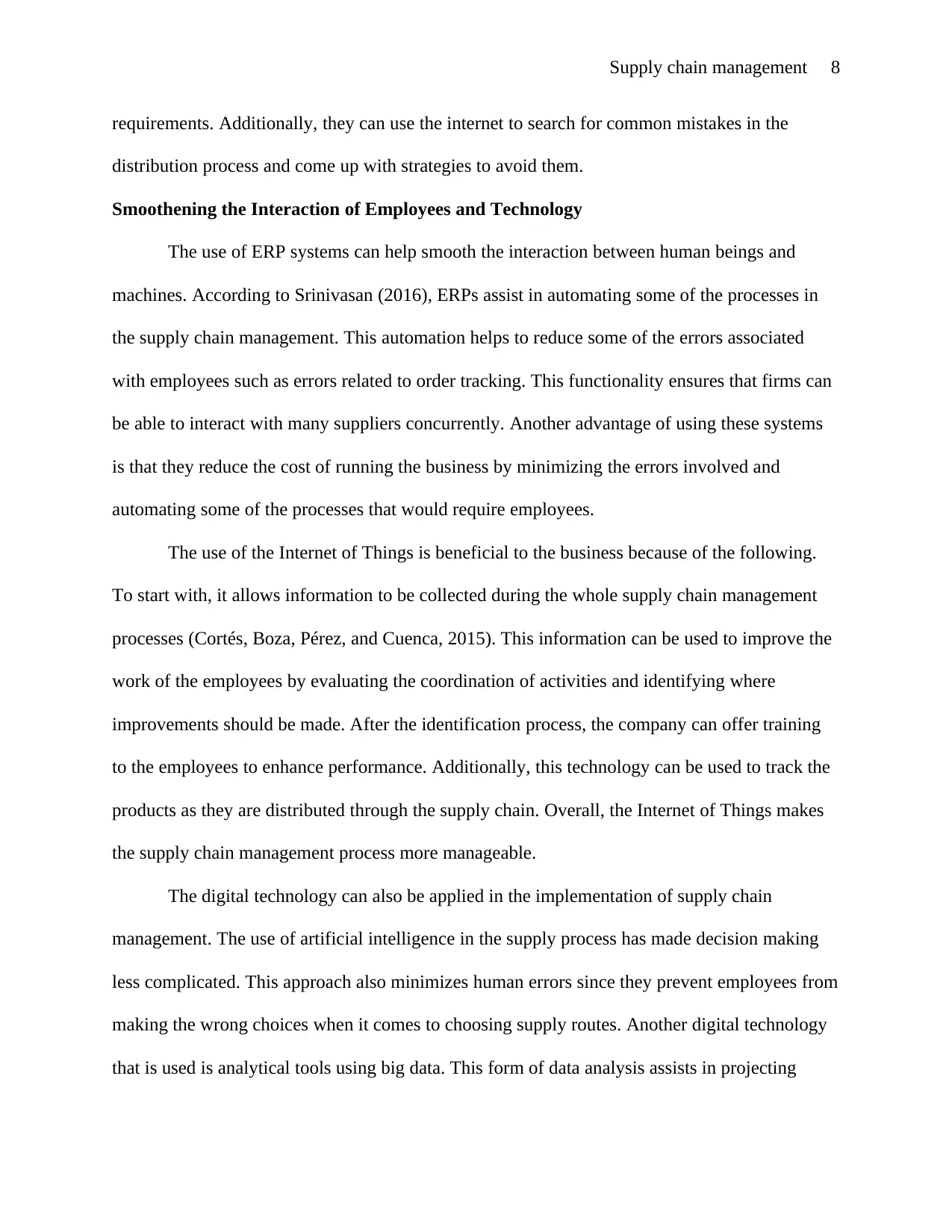
Supply chain management 8
requirements. Additionally, they can use the internet to search for common mistakes in the
distribution process and come up with strategies to avoid them.
Smoothening the Interaction of Employees and Technology
The use of ERP systems can help smooth the interaction between human beings and
machines. According to Srinivasan (2016), ERPs assist in automating some of the processes in
the supply chain management. This automation helps to reduce some of the errors associated
with employees such as errors related to order tracking. This functionality ensures that firms can
be able to interact with many suppliers concurrently. Another advantage of using these systems
is that they reduce the cost of running the business by minimizing the errors involved and
automating some of the processes that would require employees.
The use of the Internet of Things is beneficial to the business because of the following.
To start with, it allows information to be collected during the whole supply chain management
processes (Cortés, Boza, Pérez, and Cuenca, 2015). This information can be used to improve the
work of the employees by evaluating the coordination of activities and identifying where
improvements should be made. After the identification process, the company can offer training
to the employees to enhance performance. Additionally, this technology can be used to track the
products as they are distributed through the supply chain. Overall, the Internet of Things makes
the supply chain management process more manageable.
The digital technology can also be applied in the implementation of supply chain
management. The use of artificial intelligence in the supply process has made decision making
less complicated. This approach also minimizes human errors since they prevent employees from
making the wrong choices when it comes to choosing supply routes. Another digital technology
that is used is analytical tools using big data. This form of data analysis assists in projecting
requirements. Additionally, they can use the internet to search for common mistakes in the
distribution process and come up with strategies to avoid them.
Smoothening the Interaction of Employees and Technology
The use of ERP systems can help smooth the interaction between human beings and
machines. According to Srinivasan (2016), ERPs assist in automating some of the processes in
the supply chain management. This automation helps to reduce some of the errors associated
with employees such as errors related to order tracking. This functionality ensures that firms can
be able to interact with many suppliers concurrently. Another advantage of using these systems
is that they reduce the cost of running the business by minimizing the errors involved and
automating some of the processes that would require employees.
The use of the Internet of Things is beneficial to the business because of the following.
To start with, it allows information to be collected during the whole supply chain management
processes (Cortés, Boza, Pérez, and Cuenca, 2015). This information can be used to improve the
work of the employees by evaluating the coordination of activities and identifying where
improvements should be made. After the identification process, the company can offer training
to the employees to enhance performance. Additionally, this technology can be used to track the
products as they are distributed through the supply chain. Overall, the Internet of Things makes
the supply chain management process more manageable.
The digital technology can also be applied in the implementation of supply chain
management. The use of artificial intelligence in the supply process has made decision making
less complicated. This approach also minimizes human errors since they prevent employees from
making the wrong choices when it comes to choosing supply routes. Another digital technology
that is used is analytical tools using big data. This form of data analysis assists in projecting
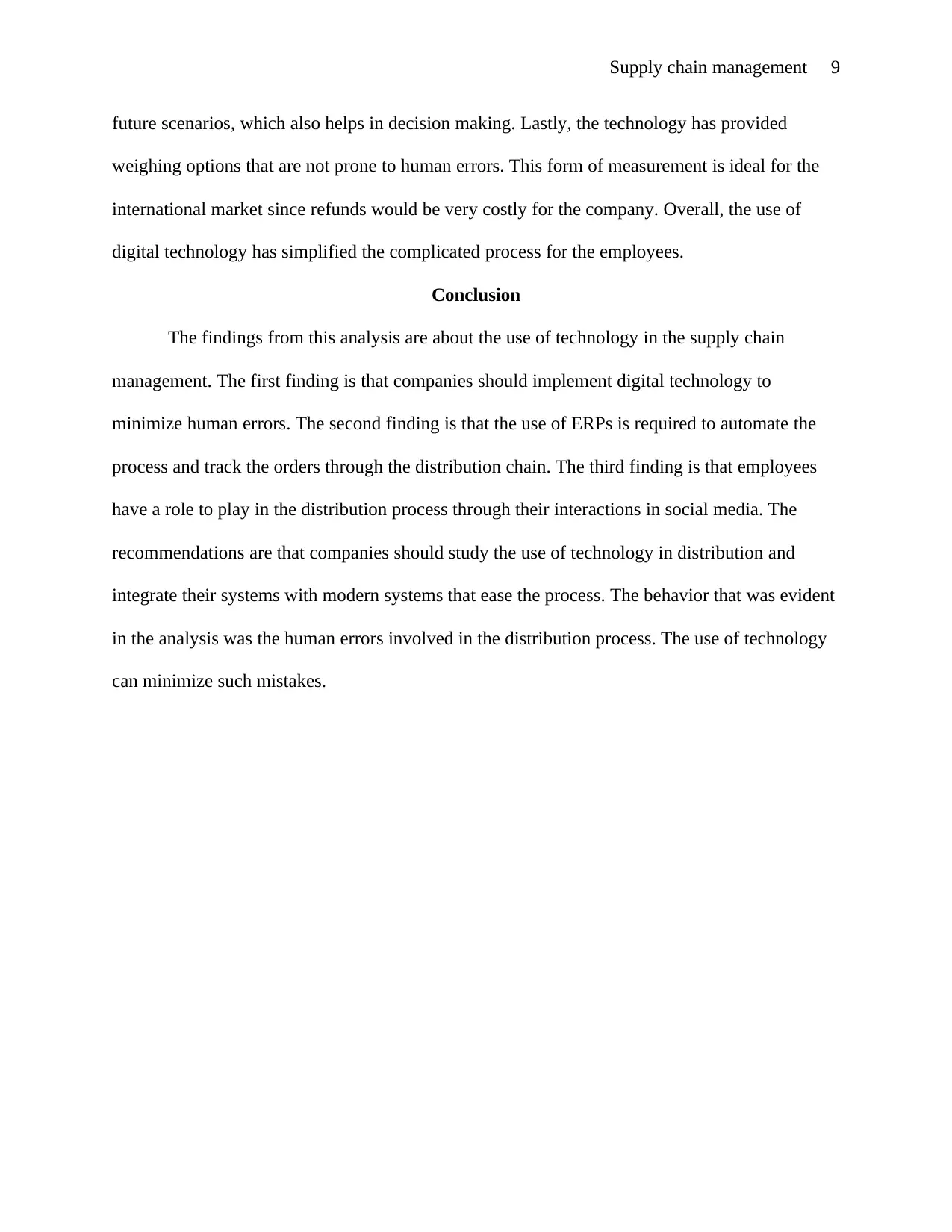
Supply chain management 9
future scenarios, which also helps in decision making. Lastly, the technology has provided
weighing options that are not prone to human errors. This form of measurement is ideal for the
international market since refunds would be very costly for the company. Overall, the use of
digital technology has simplified the complicated process for the employees.
Conclusion
The findings from this analysis are about the use of technology in the supply chain
management. The first finding is that companies should implement digital technology to
minimize human errors. The second finding is that the use of ERPs is required to automate the
process and track the orders through the distribution chain. The third finding is that employees
have a role to play in the distribution process through their interactions in social media. The
recommendations are that companies should study the use of technology in distribution and
integrate their systems with modern systems that ease the process. The behavior that was evident
in the analysis was the human errors involved in the distribution process. The use of technology
can minimize such mistakes.
future scenarios, which also helps in decision making. Lastly, the technology has provided
weighing options that are not prone to human errors. This form of measurement is ideal for the
international market since refunds would be very costly for the company. Overall, the use of
digital technology has simplified the complicated process for the employees.
Conclusion
The findings from this analysis are about the use of technology in the supply chain
management. The first finding is that companies should implement digital technology to
minimize human errors. The second finding is that the use of ERPs is required to automate the
process and track the orders through the distribution chain. The third finding is that employees
have a role to play in the distribution process through their interactions in social media. The
recommendations are that companies should study the use of technology in distribution and
integrate their systems with modern systems that ease the process. The behavior that was evident
in the analysis was the human errors involved in the distribution process. The use of technology
can minimize such mistakes.
⊘ This is a preview!⊘
Do you want full access?
Subscribe today to unlock all pages.

Trusted by 1+ million students worldwide
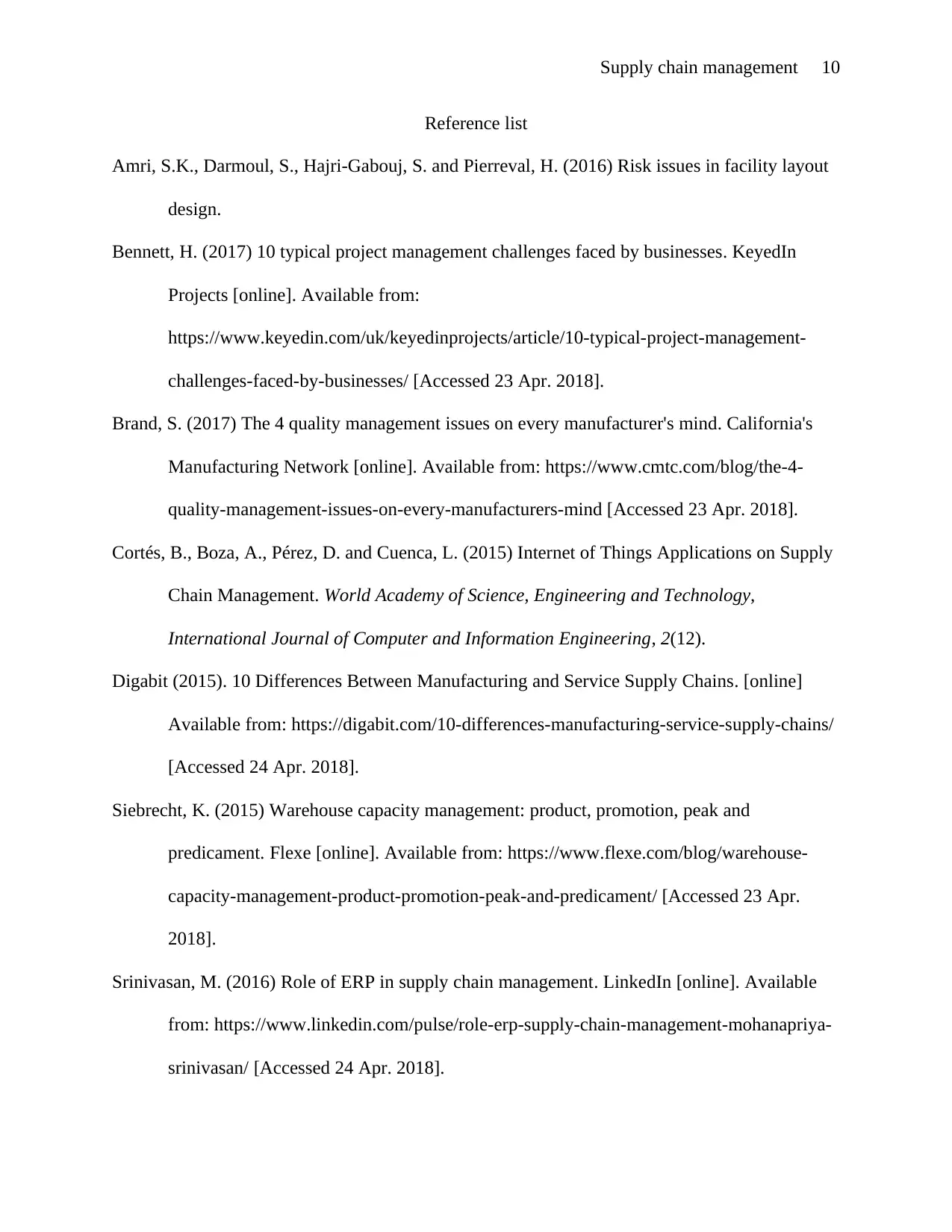
Supply chain management 10
Reference list
Amri, S.K., Darmoul, S., Hajri-Gabouj, S. and Pierreval, H. (2016) Risk issues in facility layout
design.
Bennett, H. (2017) 10 typical project management challenges faced by businesses. KeyedIn
Projects [online]. Available from:
https://www.keyedin.com/uk/keyedinprojects/article/10-typical-project-management-
challenges-faced-by-businesses/ [Accessed 23 Apr. 2018].
Brand, S. (2017) The 4 quality management issues on every manufacturer's mind. California's
Manufacturing Network [online]. Available from: https://www.cmtc.com/blog/the-4-
quality-management-issues-on-every-manufacturers-mind [Accessed 23 Apr. 2018].
Cortés, B., Boza, A., Pérez, D. and Cuenca, L. (2015) Internet of Things Applications on Supply
Chain Management. World Academy of Science, Engineering and Technology,
International Journal of Computer and Information Engineering, 2(12).
Digabit (2015). 10 Differences Between Manufacturing and Service Supply Chains. [online]
Available from: https://digabit.com/10-differences-manufacturing-service-supply-chains/
[Accessed 24 Apr. 2018].
Siebrecht, K. (2015) Warehouse capacity management: product, promotion, peak and
predicament. Flexe [online]. Available from: https://www.flexe.com/blog/warehouse-
capacity-management-product-promotion-peak-and-predicament/ [Accessed 23 Apr.
2018].
Srinivasan, M. (2016) Role of ERP in supply chain management. LinkedIn [online]. Available
from: https://www.linkedin.com/pulse/role-erp-supply-chain-management-mohanapriya-
srinivasan/ [Accessed 24 Apr. 2018].
Reference list
Amri, S.K., Darmoul, S., Hajri-Gabouj, S. and Pierreval, H. (2016) Risk issues in facility layout
design.
Bennett, H. (2017) 10 typical project management challenges faced by businesses. KeyedIn
Projects [online]. Available from:
https://www.keyedin.com/uk/keyedinprojects/article/10-typical-project-management-
challenges-faced-by-businesses/ [Accessed 23 Apr. 2018].
Brand, S. (2017) The 4 quality management issues on every manufacturer's mind. California's
Manufacturing Network [online]. Available from: https://www.cmtc.com/blog/the-4-
quality-management-issues-on-every-manufacturers-mind [Accessed 23 Apr. 2018].
Cortés, B., Boza, A., Pérez, D. and Cuenca, L. (2015) Internet of Things Applications on Supply
Chain Management. World Academy of Science, Engineering and Technology,
International Journal of Computer and Information Engineering, 2(12).
Digabit (2015). 10 Differences Between Manufacturing and Service Supply Chains. [online]
Available from: https://digabit.com/10-differences-manufacturing-service-supply-chains/
[Accessed 24 Apr. 2018].
Siebrecht, K. (2015) Warehouse capacity management: product, promotion, peak and
predicament. Flexe [online]. Available from: https://www.flexe.com/blog/warehouse-
capacity-management-product-promotion-peak-and-predicament/ [Accessed 23 Apr.
2018].
Srinivasan, M. (2016) Role of ERP in supply chain management. LinkedIn [online]. Available
from: https://www.linkedin.com/pulse/role-erp-supply-chain-management-mohanapriya-
srinivasan/ [Accessed 24 Apr. 2018].
Paraphrase This Document
Need a fresh take? Get an instant paraphrase of this document with our AI Paraphraser
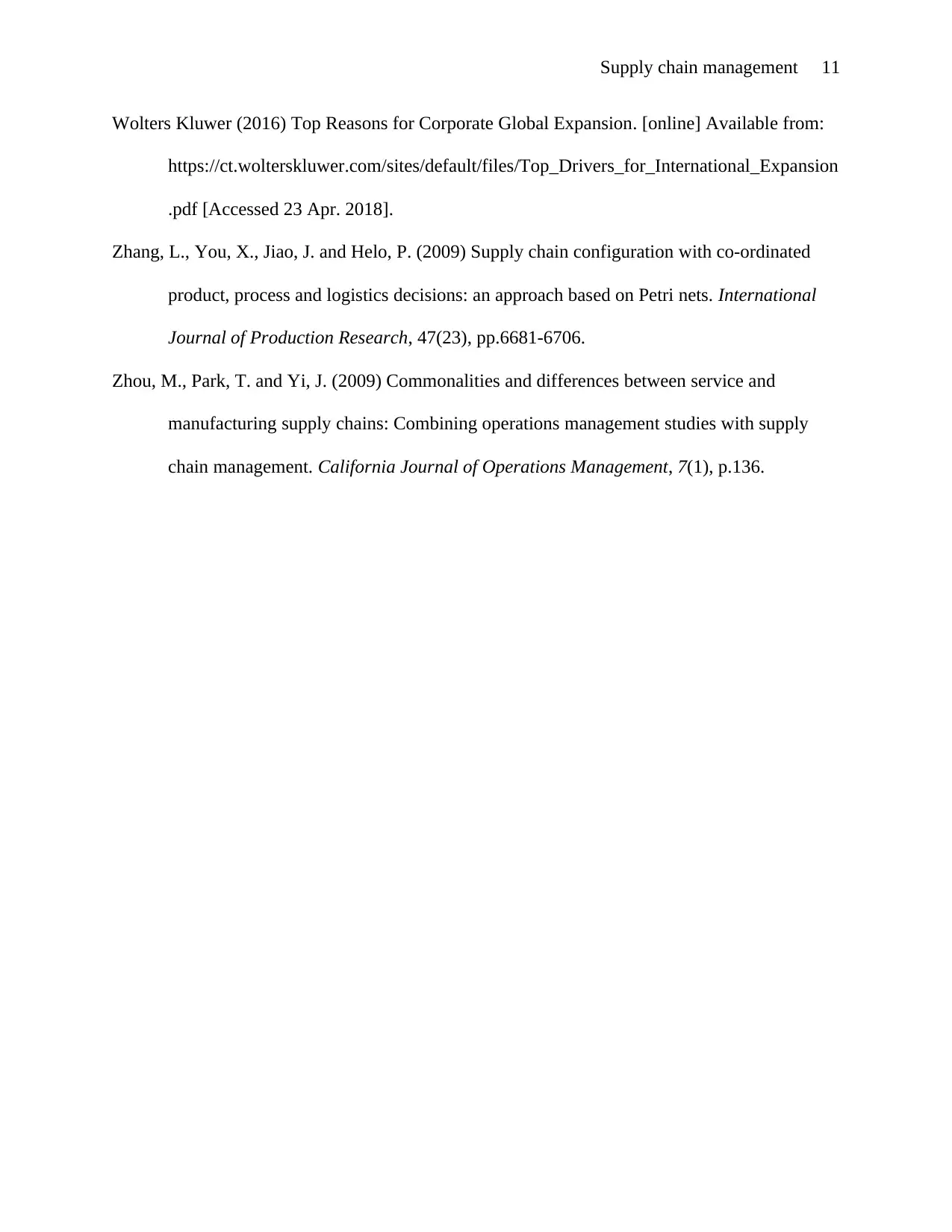
Supply chain management 11
Wolters Kluwer (2016) Top Reasons for Corporate Global Expansion. [online] Available from:
https://ct.wolterskluwer.com/sites/default/files/Top_Drivers_for_International_Expansion
.pdf [Accessed 23 Apr. 2018].
Zhang, L., You, X., Jiao, J. and Helo, P. (2009) Supply chain configuration with co-ordinated
product, process and logistics decisions: an approach based on Petri nets. International
Journal of Production Research, 47(23), pp.6681-6706.
Zhou, M., Park, T. and Yi, J. (2009) Commonalities and differences between service and
manufacturing supply chains: Combining operations management studies with supply
chain management. California Journal of Operations Management, 7(1), p.136.
Wolters Kluwer (2016) Top Reasons for Corporate Global Expansion. [online] Available from:
https://ct.wolterskluwer.com/sites/default/files/Top_Drivers_for_International_Expansion
.pdf [Accessed 23 Apr. 2018].
Zhang, L., You, X., Jiao, J. and Helo, P. (2009) Supply chain configuration with co-ordinated
product, process and logistics decisions: an approach based on Petri nets. International
Journal of Production Research, 47(23), pp.6681-6706.
Zhou, M., Park, T. and Yi, J. (2009) Commonalities and differences between service and
manufacturing supply chains: Combining operations management studies with supply
chain management. California Journal of Operations Management, 7(1), p.136.
1 out of 11
Related Documents
Your All-in-One AI-Powered Toolkit for Academic Success.
+13062052269
info@desklib.com
Available 24*7 on WhatsApp / Email
![[object Object]](/_next/static/media/star-bottom.7253800d.svg)
Unlock your academic potential
Copyright © 2020–2025 A2Z Services. All Rights Reserved. Developed and managed by ZUCOL.





